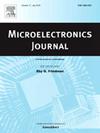A double-modules interlocking triple-node upset-tolerant latch design
IF 1.9
3区 工程技术
Q3 ENGINEERING, ELECTRICAL & ELECTRONIC
引用次数: 0
Abstract
In the design of nanoscale latches, multi-node upset (MNU) caused by charge-sharing effects are a major reliability issue. To effectively tolerate MNU under single event effects (SEE), this paper proposes a double-modules interlocking triple-node upset (DMITNU) tolerant latch design. Based on the radiation upset mechanism, utilizing polarity hardened and source isolation techniques, the proposed DMITNU latch can effectively reduce the number of sensitive nodes. The interlocking connection of two basic modules not only cleverly reduces the number of transistors, thereby lowering circuit overhead, but also enhances the MNU radiation tolerance characteristics of the DMITNU latch. Fault injection methods verified the recovery tolerance of the proposed latch. Compared to advanced TNU tolerant latch designs, the proposed DMITNU latch achieved an average improvement of 61 % in the area-power-delay-product (PDAP). Analysis of PVT variations confirmed that the DMITNU latch maintains good stability under harsh environments. Additionally, Monte Carlo (MC) simulations demonstrated that the DMITNU latch has excellent data storage reliability.
双模块联锁三节点容错锁存器设计
在纳米级锁存器的设计中,电荷共享效应引起的多节点扰动是一个主要的可靠性问题。为了有效地容忍单事件效应(SEE)下的MNU,本文提出了一种双模块联锁三节点扰动(DMITNU)容忍锁存设计。基于辐射干扰机制,利用极性硬化和源隔离技术,提出的DMITNU锁存可以有效地减少敏感节点的数量。两个基本模块的联锁连接不仅巧妙地减少了晶体管的数量,从而降低了电路开销,而且提高了DMITNU锁存器的MNU耐辐射特性。故障注入方法验证了所提锁存器的恢复容忍度。与先进的耐TNU锁存器设计相比,所提出的DMITNU锁存器在面积-功率延迟积(PDAP)方面平均提高了61%。PVT变化分析证实,DMITNU闩锁在恶劣环境下保持良好的稳定性。此外,蒙特卡罗(MC)模拟表明,DMITNU锁存具有优异的数据存储可靠性。
本文章由计算机程序翻译,如有差异,请以英文原文为准。
求助全文
约1分钟内获得全文
求助全文
来源期刊

Microelectronics Journal
工程技术-工程:电子与电气
CiteScore
4.00
自引率
27.30%
发文量
222
审稿时长
43 days
期刊介绍:
Published since 1969, the Microelectronics Journal is an international forum for the dissemination of research and applications of microelectronic systems, circuits, and emerging technologies. Papers published in the Microelectronics Journal have undergone peer review to ensure originality, relevance, and timeliness. The journal thus provides a worldwide, regular, and comprehensive update on microelectronic circuits and systems.
The Microelectronics Journal invites papers describing significant research and applications in all of the areas listed below. Comprehensive review/survey papers covering recent developments will also be considered. The Microelectronics Journal covers circuits and systems. This topic includes but is not limited to: Analog, digital, mixed, and RF circuits and related design methodologies; Logic, architectural, and system level synthesis; Testing, design for testability, built-in self-test; Area, power, and thermal analysis and design; Mixed-domain simulation and design; Embedded systems; Non-von Neumann computing and related technologies and circuits; Design and test of high complexity systems integration; SoC, NoC, SIP, and NIP design and test; 3-D integration design and analysis; Emerging device technologies and circuits, such as FinFETs, SETs, spintronics, SFQ, MTJ, etc.
Application aspects such as signal and image processing including circuits for cryptography, sensors, and actuators including sensor networks, reliability and quality issues, and economic models are also welcome.
 求助内容:
求助内容: 应助结果提醒方式:
应助结果提醒方式:


